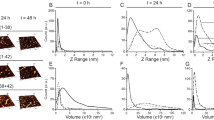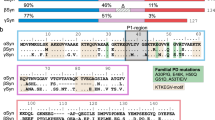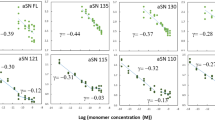Abstract
Protein misfolding is the basis of a number of human diseases and presents an obstacle to the production of soluble recombinant proteins. We present a general method to assess the solubility and folding of proteins in vivo. The basis of this assay is structural complementation between the α- and ω- fragments of β-galactosidase (β-gal). Fusions of the α-fragment to the C terminus of target proteins with widely varying in vivo folding yield and/or solubility levels, including the Alzheimer's amyloid β (Aβ) peptide and a non-amyloidogenic mutant thereof, reveal an unambiguous correlation between β-gal activity and the solubility/folding of the target. Thus, structural complementation provides a means of monitoring protein solubility/misfolding in vivo, and should find utility in the screening for compounds that influence the pathological consequences of these processes.
This is a preview of subscription content, access via your institution
Access options
Subscribe to this journal
Receive 12 print issues and online access
$209.00 per year
only $17.42 per issue
Buy this article
- Purchase on SpringerLink
- Instant access to full article PDF
Prices may be subject to local taxes which are calculated during checkout





Similar content being viewed by others
References
Houry, W.A., Frishman, D., Eckerskorn, C., Lottspelch, F. & Hartl, F.U. Identification of in vivo substrates of the chaperonin GroEL. Nature 402, 147–154 (1999).
Huang, B., Eberstadt, M., Olejniczak, E.T., Meadows, R.P. & Fesik, S.W. NMR structure and mutagenesis of the Fas (APO-1/CD95) death domain. Nature 384, 638–641 (1996).
King, J. & Betts, S. A green light for protein folding. Nat. Biotechnol. 17, 637–638 (1999).
Brown, C.R., Hong-Brown, L.Q. & Welch, W.J. Correcting temperature-sensitive protein folding defects. J. Clin. Invest. 99, 1432–1444 (1997).
Blackwell, J.R. & Horgan, R. A novel strategy for production of a highly expressed recombinant protein in an active form. FEBS Lett. 295, 10–12 (1991).
Bourot,S. et al. Glycine betaine-assisted protein folding in a lysA mutant of Escherichia coli. J. Biol. Chem. 275, 1050–1056 (2000).
Sugihara, J. & Baldwin, T.O. Effects of 3′ end deletions from Vibrio harveyi luxB gene on luciferase subunit folding and enzyme assembly: generation of temperature-sensitive polypeptide folding mutants. Biochemistry 27, 2872–2880 (1988).
Wynn, R.M., Davie, J.R., Cox, R.P. & Chuang, D.T. Chaperonins groEL and groES promote assembly of heterotetramers (alpha 2 beta 2) of mammalian mitochondrial branched-chain alpha-keto acid decarboxylase in Escherichia coli. J. Biol. Chem. 267, 12400–12403 (1992).
Thomas, P.J., Qu, B.-H. & Pedersen, P.L. Defective protein folding as a basis of human disease. Trends Biochem. Sci. 20, 456–459 (1995).
Dobson, C.M. Protein misfolding, evolution and disease. Trends Biochem. Sci. 24, 329–332 (1999).
Thomas, P.J., Ko, Y.H. & Pedersen, P.L. Altered protein folding may be the molecular basis of most cases of cystic fibrosis. FEBS Lett. 312, 7–9 (1992).
Rao, V.R., Cohen, G.B. & Oprian, D.D. Rhodopsin mutation G90D and a molecular mechanism for congenital night blindness. Nature 367, 639–642 (1994)
Tan, S.Y. & Pepys, M.B. Amyloidosis. Histopathology 25, 403–414 (1994).
Harper, J.D. & Lansbury, P.T. Jr. Models of amyloid seeding in Alzheimer's disease and scrapie: mechanistic truths and physiological consequences of the time-dependent solubility of amyloid proteins. Annu. Rev. Biochem. 66, 385–407 (1997).
Bruijn, S. et al. Aggregation and motor neuron toxicity of an ALS-linked SOD1 mutant independent from wild-type SOD1. Science 281, 1851–1853 (1998).
Galvin, J.E., Uryu, K., Lee, V.M. & Trojanowski, J.Q. Axon pathology in Parkinson's disease and Lewy body dementia hippocampus contains alpha-, beta-, and gamma-synuclean. Proc. Natl. Acad. Sci. USA 96, 13450–13455 (1999).
Prusiner, S.B. Prions. Proc. Natl. Acad. Sci. USA 95, 13383 (1998).
Hind, C.R., Tennent, G.A., Evans, D.J. & Pepys, M.B. Demonstration of amyloid A (AA) protein and amyloid P component (AP) in deposits of systemic amyloidosis associated with renal adenocarcinoma. J. Pathol. 139, 159–166 (1983).
Colon, W. & Kelly, J.W. Partial denaturation of transthyretin is sufficient for amyloid fibril formation in vitro. Biochemistry 31, 8654–8660 (1992).
Martin, J.B. & Gusella, J.F. Huntington's disease: pathogenesis and management. N. Engl. J. Med. 315, 1267–1276 (1986).
The Huntington's Disease Collaborative Research Group. A novel gene containing a trinucleotide repeat that is expanded and unstable on Huntington's disease chromosomes. Cell 72, 971–983 (1993).
Davies, S.W. et al. Formation of neuronal intranuclear inclusions underlies the neurological dysfunction in mice transgenic for the HD mutation. Cell 90, 537–548 (1997).
Wells, R.D. & Warren, S.T. Genetic instabilities and hereditary neurological diseases. (Academic Press, San Diego, CA; 1998).
La Spada, A.R., Wilson, E.M., Lubahn, D.B., Harding, A.E. & Fischbeck, K.H. Androgen receptor gene mutations in X-linked spinal and bulbar muscular atrophy. Nature 352, 77–79 (1991).
Fischbeck, K.H., Lieberman, A., Bailey, C.K., Abel, A. & Merry, D.E. Androgen receptor mutation in Kennedy's disease. Phil. Trans. R. Soc. Lond. B 354, 1075–1078 (1999).
Kawaguchi, Y. et al. CAG expansions in a novel gene for Machado–Joseph disease at chromosome 14q32.1. Nat. Genet. 8, 221–228 (1994).
Richards, F.M. & Vithayatil, P.J. The preparation of subtilisin-modified ribonuclease and the separation of the peptide and protein components. J. Biol. Chem. 234, 1459–1465 (1959).
Ullmann, A., Jacob, F. & Monod, J. Characterization by in vitro complementation of a peptide corresponding to an operator-proximal segment of the β-galactosidase structural gene of Escherichia coli. J. Mol. Biol. 24, 339–343 (1967).
Taniuchi, H. & Anfinsen, C.B. Simultaneous formation of two alternative enzymology active structures by complementation of two overlapping fragments of staphylococcal nuclease. J. Biol. Chem. 246, 2291–1301 (1971).
Shiba, K. & Schimmel, P. Functional assembly of a randomly cleaved protein. Proc. Natl. Acad. Sci. USA 89, 1880–1884 (1992).
Pecorari, F., Minard, P., Desmadril, M. & Yon, J.M. Structure and functional complementation of engineered fragments from yeast phosphoglycerate kinase. Protein Eng. 6, 313–325 (1993).
Johnsson, N. & Varshavsky, A. Split ubiquitin as a sensor of protein interactions in vivo. Proc. Natl. Acad. Sci. USA 91, 10340–10344 (1994).
Schonberger, O., Knox, C., Bibi, E. & Pines, O. Split invertase polypeptides form functional complexes in the yeast periplasm in vivo. Proc. Natl. Acad. Sci. USA 93, 9612–9617 (1996).
Rossi, F., Charlton, C.A. & Blau, H. Monitoring protein–protein interactions in intact eukaryotic cells by β-galactosidase complementation. Proc. Natl. Acad. Sci. USA 94, 8405–8410 (1997).
Karimova, G., Pidoux, J., Ullmann, A. & Ladant, D. A bacterial two-hybrid system based on a reconstituted signal transduction pathway. Proc. Natl. Acad. Sci. USA 95, 5752–5756 (1998).
Pelletier, J.N., Campbell-Valois, F.-X. & Michnick, S.W. Oligomerization domain-directed reassembly of active dihydrofolate reductase from rationally designed fragments. Proc. Natl. Acad. Sci. USA 95, 12141–12146 (1998).
Pelletier, J.N., Arndt, K.M., Pluckthun, A. & Michnick, S.W. An in vivo library-versus-library selection of optimized protein–protein interactions. Nat. Biotechnol. 17, 683–690 (1999).
Zabin, I. & Villarejo, M.R. Protein complementation. Annu. Rev. Biochem. 44, 296–314 (1975).
Welply, J.K., Fowler, A.V. & Zabin, I. β-Galactosidase α–complementation. J. Biol. Chem. 256, 6811–6816 (1981).
Lee, S.C., Choi, Y.C. & Yu, M.H. Effect of the N-terminal hydrophobic sequence of hepatitis B virus antigen on the folding and assembly of hybrid beta-galactosidase in Escherichia coli. Eur. J. Biochem. 187, 417–424 (1990).
Waldo, G.S., Standish, B.M., Berendzen, J. & Terwilliger, T.C. Rapid protein-folding assay using green fluorescent protein. Nat. Biotechnol. 17, 691–695 (1999).
Maxwell, K.L., Mittermaier, A.K., Forman-Kay, J.D. & Davidson, A.R. A simple in vivo assay for increased protein solubility. Protein Sci. 8, 1908–1911 (1999).
Yanish-Perron, C., Vieira, J. & Messing, J. Improved M13 phage cloning vectors and host strains: nucleotide sequences of the M13mp18 and pUC19 vectors. Gene 33, 103–119 (1985).
Betton, J.-M. & Hofnung, M. Folding of a mutant maltose-binding protein of Escherichia coli which forms inclusion bodies. J. Biol. Chem. 271, 8046–8052 (1996).
Huang, K.X., Huang, Q.L., Wildung, M.R., Croteau, R. & Scott, A.I. Overproduction, in Escherichia coli, of soluble taxadiene synthase, a key enzyme in the Taxol biosynthetic pathway. Protein Expr. Purif. 13, 90–96 (1998).
King, S.A. & Sorscher, E.J. Recombinant synthesis of cystic fibrosis transmembrane conductance regulator and functional nucleotide-binding domains. Methods Enzymol. 292, 686–697 (1998).
Qu, B.-H. & Thomas, P.J. Alteration of the cystic fibrosis transmembrane conductance regulator folding pathway: effects of the deta-F508 mutation on the thermodynamic stability and folding yield of NBD1. J. Biol. Chem. 271, 7261–7264 (1996).
Ko, Y.H., Thomas, P.J., Delannoy, M.R. & Pedersen, P.L. The cystic fibrosis transmembrane conductance regulator. Overexpression, purification, and characterization of wild type and ΔF508 mutant forms of the first nucleotide binding fold in fusion with the maltose-binding protein. J. Biol. Chem. 268, 24330–24338 (1993).
Wood, S.J., Wetzel, R., Martin, J.D. & Hurle, M.R. Prolines and amyloidogenicity in fragments of the Alzheimer's peptide β/A4. Biochemistry 34, 724–730. (1995).
Culvenor, J.G. et al. Subcellular localization of the Alzheimer's disease amyloid precursor protein and derived polypeptides expressed in a recombinant yeast system. Amyloid: Int. J. Exp. Clin. Invest. 5, 79–89 (1998).
Kazantsev, A., Preisinger, E., Dranovsky, A., Goldgaber, D. & Housman, D. Insoluble detergent-resistant aggregates form between pathological and nonpathological lengths of polyglutamine in mammalian cells. Proc. Natl. Acad. Sci. USA 96, 11404–11409 (1999).
Senut, M.C., Suhr, S.T., Kaspar, B. & Gage, F.H. Intraneuronal aggregate formation and cell death after viral expression of expanded polyglutamine tracts in the adult rat brain. J. Neurosci. 20, 219–229 (2000).
Luzzago, A. & Cesareni, G. Isolation of point mutations that affect the folding of the H chain of human ferritin in E. coli. EMBO J. 8, 569–576 (1989).
Jappelli, R., Luzzago, A., Tataseo, P., Pernice, I. & Cesareni, G. Loop mutations can cause a substantial conformation change in the carboxy terminus of the ferritin protein. J. Mol. Biol. 227, 532–543 (1992).
Bell, E.T. Hyalinization of the islets of Langerhans in diabetes mellitus. Diabetes 1, 344 (1952).
Hainaut, P. & Milner, J. Interaction of heat-shock protein 70 with p53 translated in vitro: evidence for interaction with dimeric p53 and for a role in the regulation of p53 conformation. EMBO J. 11, 3513–3520 (1992).
Foster, B.A., Coffey, H.A., Morin, M.J. & Rastinejad, F. Pharmacological rescue of mutant p53 conformation and function. Science 286, 2507–2510 (1999).
Hung, L.W. et al. Crystal structure of the ATP-binding subunit of an ABC transporter. Nature 396, 703–707 (1998).
Schagger, H. & von Jagow, G. Tricine–sodium dodecyl sulfate–polyacrylamide gel electrophoresis for the separation of proteins in the range from 1 to 100 kDa. Anal. Biochem. 166, 368–379 (1987).
Acknowledgements
We thank S. Muallem for helpful discussions and encouragement, M. Corboy for critical review of the manuscript, and members of our laboratories for helpful comments. This work was supported by a research grant from the Haberecht Foundation to W.C.W., a startup grant from Columbia University to J.F.H., and grants from the National Institutes of Health–National Institute of Diabetes and Digestive and Kidney Diseases and the Cystic Fibrosis Foundation to P.J.T.
Author information
Authors and Affiliations
Corresponding author
Rights and permissions
About this article
Cite this article
Wigley, W., Stidham, R., Smith, N. et al. Protein solubility and folding monitored in vivo by structural complementation of a genetic marker protein. Nat Biotechnol 19, 131–136 (2001). https://doi.org/10.1038/84389
Received:
Accepted:
Issue Date:
DOI: https://doi.org/10.1038/84389
This article is cited by
-
Ultraviolet optical horn antennas for label-free detection of single proteins
Nature Communications (2022)
-
Engineering a hydroxysteroid dehydrogenase to improve its soluble expression for the asymmetric reduction of cortisone to 11β-hydrocortisone
Applied Microbiology and Biotechnology (2014)
-
Techniques for monitoring protein misfolding and aggregation in vitro and in living cells
Korean Journal of Chemical Engineering (2012)
-
Filtering "genic" open reading frames from genomic DNA samples for advanced annotation
BMC Genomics (2011)
-
Large-scale experimental studies show unexpected amino acid effects on protein expression and solubility in vivo in E. coli
Microbial Informatics and Experimentation (2011)



